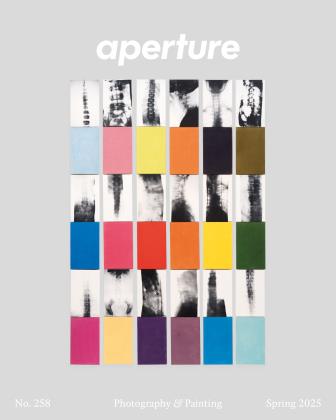Shirana Shahbazi Palimpsest
Negar Azimi
A man in a long-sleeved white shirt and dark pants, a familiar sort of business casual, looks out into the distance. The man is standing in water or in sand—it’s hard to tell which—hands in his pockets. Is he a city rat transplanted to the beach? A human seeking enlightenment? The photograph offers no answers.
Blocks of image and color—orange, magenta—overlay the central photograph, which is black and white but perhaps tinged with blue. One of the pictures overlapping the man is difficult to make out but appears to be architectural in nature. The blocks of color are translucent, filmy, striated by skinny white lines—the photographic equivalent of wrinkles? They feel akin to Fdlix Gonzalez-Torres’s pellucid curtains: both preamble and main act at once.
The picture described above, part of a recent series by the artist Shirana Shahbazi, evokes the disorientation one might experience when roused from a dream. Places, faces, narrative arc—a collision of improbable things. If the mindscape is a palimpsest of antic psychic forces, Shahbazi’s collage-like works translate this into visual form.
The images themselves are not precious. Most were taken with an iPhone. Others are stills from a video piece. In most cases, the artist printed and rephotographed them—hence degrading them, adding new layers, fresh complexities. Hardly pure, the images seem to mimic the workings of memory; they are porous, textured, malleable.
Shahbazi told me that much of the thinking behind the series happened amid the backdrop of the Woman, Life, Freedom protests that shook Iran in the fall of 2022. A resident of Zurich but tied to Iran by family and origin, she felt tugged in multiple directions—glued to social media, following the events from afar while simultaneously steeped in square Swiss life. The persistent layering evident in her art, which is sometimes encased in handmade ceramic frames, only serves to mirror this schizophrenic condition. One is reminded of W. H. Auden’s 1938 poem “Musde des Beaux Arts”:
About suffering they were never wrong, The Old Masters: how well they understood Its human position; how it takes place While someone else is eating or opening a window or just walking dully along
There is much to be said about color. Shahbazi, whose early work was marked by stirring riffs on art-historical genres— still lifes and portraits in particular— has long embraced color as a means of achieving abstraction, of scrambling surface and depth. She does it again here, deploying an electric palette to create dimensionalities that illuminate photography’s qualities as a promiscuous medium.
While taking part in an artist residency in India, in 2018, Shahbazi came across the traditional hand-tinting techniques that characterize old-school photography studios—techniques that have all but disappeared in the digital age. She embraced the vernacular form. The hand tinting lends a painterly air to her collages, a photographic corollary, perhaps, to Hans Hofmann’s signature “push and pull” paintings, in which colors recede and emerge from the picture plane like elements in a symphonic score.
Within the artist’s polychrome world, we find: a flailing body submerged in water, an old sedan idling in a garage, a sequence of walls demarcating the inside or outside of a building (it’s entirely unclear which), a collision of luxuriant red and pink, silicone-like, partially translucent. Are these serendipitous accidents in the darkroom? Feats of digital manipulation? An air of mystery perfumes Shahbazi’s conjured images.
Negar Azimi is a writer and editor in chief of Bidoun.
 View Full Issue
View Full Issue
More From This Issue
-

Njideka Akunyili Crosby Endless Returns
SPRING 2025 By Ikechúkwú Onyewuenyi -

Vija Celmins The Surface Of Things
SPRING 2025 -

Christopher Wool See Stop Run Print
SPRING 2025 -

Kunié Sugiura Liquid Light.
SPRING 2025 By Erin O'Toole -

Photorealism's Living History
SPRING 2025 By Lucy Ives -

In The Studio
SPRING 2025 By Brian Dillon










